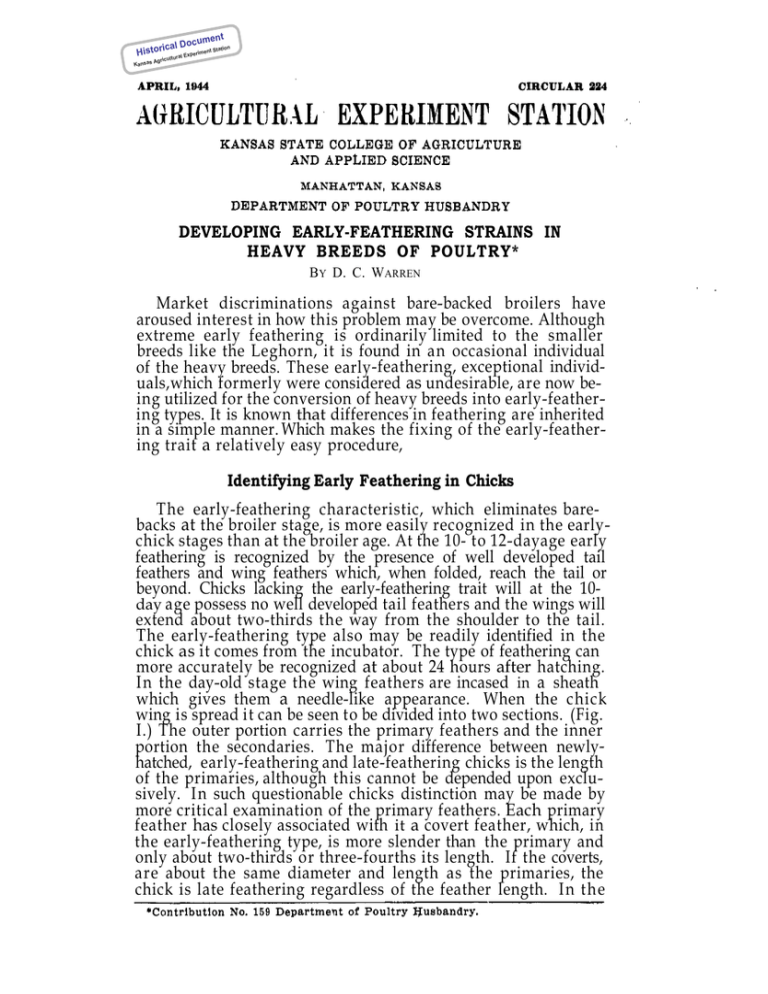DEVELOPING EARLY-FEATHERING STRAINS IN HEAVY BREEDS OF POULTRY*
advertisement

Kansas t cumen cal Do Histori tural Agricul Experim ion ent Stat DEVELOPING EARLY-FEATHERING STRAINS IN HEAVY BREEDS OF POULTRY* BY D. C. WARREN Market discriminations against bare-backed broilers have aroused interest in how this problem may be overcome. Although extreme early feathering is ordinarily limited to the smaller breeds like the Leghorn, it is found in an occasional individual of the heavy breeds. These early-feathering, exceptional individuals,which formerly were considered as undesirable, are now being utilized for the conversion of heavy breeds into early-feathering types. It is known that differences in feathering are inherited in a simple manner. Which makes the fixing of the early-feathering trait a relatively easy procedure, Identifying Early Feathering in Chicks The early-feathering characteristic, which eliminates barebacks at the broiler stage, is more easily recognized in the earlychick stages than at the broiler age. At the 10- to 12-dayage early feathering is recognized by the presence of well developed tail feathers and wing feathers which, when folded, reach the tail or beyond. Chicks lacking the early-feathering trait will at the 10day age possess no well developed tail feathers and the wings will extend about two-thirds the way from the shoulder to the tail. The early-feathering type also may be readily identified in the chick as it comes from the incubator. The type of feathering can more accurately be recognized at about 24 hours after hatching. I n the day-old stage the wing feathers are incased in a sheath which gives them a needle-like appearance. When the chick wing is spread it can be seen to be divided into two sections. (Fig. I.) The outer portion carries the primary feathers and the inner portion the secondaries. The major difference between newlyhatched, early-feathering and late-feathering chicks is the length of the primaries, although this cannot be depended upon exclusively. I n such questionable chicks distinction may be made by more critical examination of the primary feathers. Each primary feather has closely associated with it a covert feather, which, in the early-feathering type, is more slender than the primary and only about two-thirds or three-fourths its length. If the coverts, are about the same diameter and length as the primaries, the chick is late feathering regardless of the feather length. I n t h e t cumen cal Do Histori Kansas riment ral Expe ricultu Station Ag more common late-feathering type the wing feathers will be so poorly developed that identification easily may be made, but the relative lengths of the primaries and coverts aid in identifying late-feathering chicks with exceptionally long wing feathers. It has been found that among the early-feathering individuals, those having the highest number of secondaries are of the earliest feathering tendencies. So in the initial stages of establishing an early-feathering strain, one probably should also eliminate those chicks with too few secondaries. The secondaries vary in number from two to eight which conspicuously show in the down. The highest number is desirable but good broiler feathering can be expected when the number of secondaries exceeds three. The nature of the wing feathering most easily can be seen by spreading the wing and holding it between the eye and a strong light. The accompanying photographs bring out the differences emphasized. In classifying a group of chicks which are younger than 24 hours, the early-feathering chick will have slightly shorter wing feathers than are illustrated in Figure 2A: If the chicks are allowed to go beyond the ideal age, many of the late-feathering chicks may appear like the one illustrated in Figure 2C. Matings for Establishing Early Feathering If ones finds early feathering i n both males a n d females, he needs only to m a t e them for producing a flock which will breed t r u e f o r early feathering. If early feathering occurs rarely i n a f l o c k , such individuals, a r e more likely to b e females. F o r promptly establishing early feathering in a flock, it is desirable to obtain a male showing t h e trait, since females cannot trans- t cumen cal Do Histori riment Kans Expe ultural as Agric Station t cumen cal Do Histori riment Kans Expe ultural as Agric Station

![Information-about-Emus-E2-August-Week-6-1gssrwn[1]](http://s2.studylib.net/store/data/009885786_1-bd45c822c216cb2e8ac8bd79e7ddb6d0-300x300.png)
